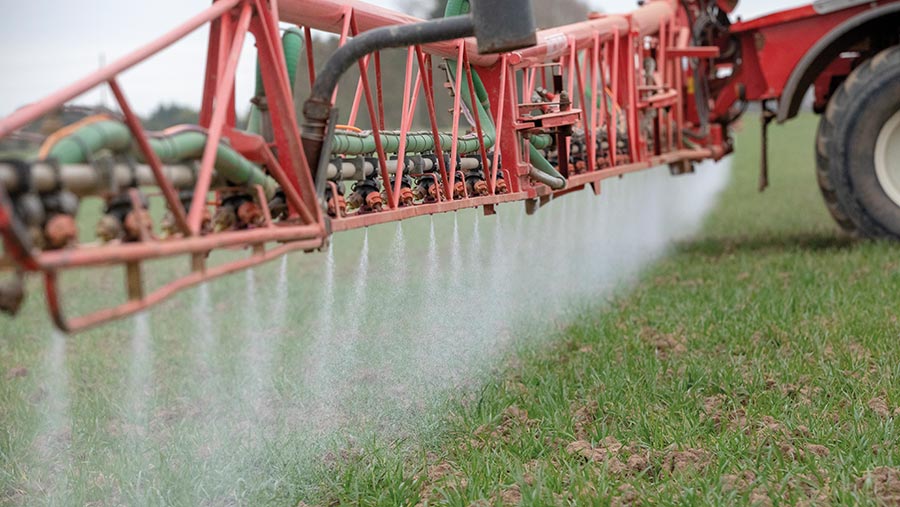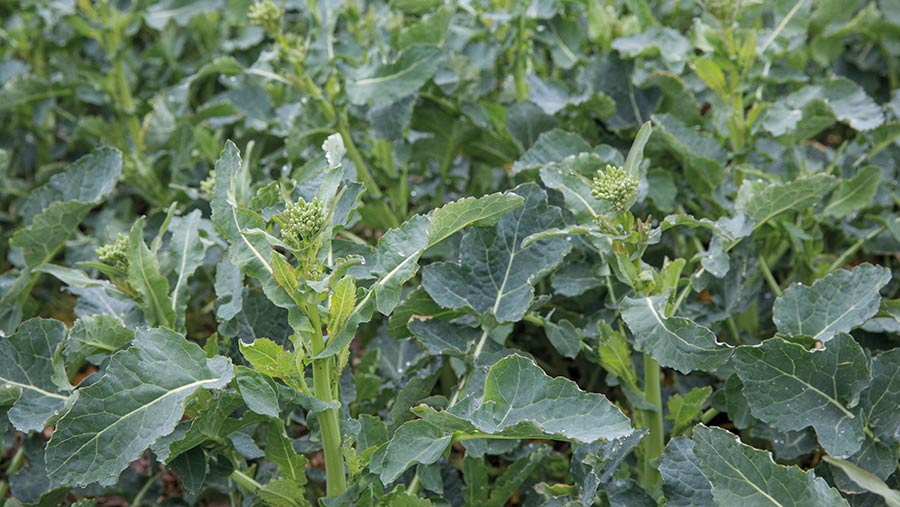Crop Watch: Wet weather woes as field jobs pile up
 © Gary Naylor
© Gary Naylor Frustration is now setting in as the jobs list grows ever longer because of the unsettled March weather.
There have been few spray days and disease pressure is building up.
Most OSR crops are at some stage of stem extension and, with green buds appearing, crops will be flowering in April.
The hope is that there isn’t a return to hard frosts like in April 2021.
North: David Martindale
Arable Alliance (Yorkshire)
March has thrown up just about every conceivable type of weather.
The main culprits have been persistent winds and rain, which have severely limited any kind of fieldwork.
As a result there are now large backlogs of sprayer and fertiliser applications, along with the sowing of spring crops.
The February glow of feeling on top of jobs has changed during March to frustration and desperation.
Winter cereals overall look well. Even where no nitrogen fertiliser has been applied they have not turned pale or yellow.
See also: How to improve consistency with foliar nitrogen sprays
In winter wheat the T0 timing is approaching as crops move into stem extension.
Early-sown crops that are susceptible to Septoria tritici are showing high levels of infection.
Yellow rust has been repeatedly checked by frosts and cold weather, but it is now more prevalent.
The weather during the past 10 days has also been ideal for yellow rust’s development. Tebuconazole will be used at T0 to keep it under control.
Winter barley crops are well tillered, which bodes well for good yield potential.
They are carrying high levels of disease, though, most notably net blotch and brown rust.
Rust levels in some hybrid varieties has been exceptionally high.
Robust T1 fungicide rates will shortly be required to prevent these diseases spreading up the canopy.
Stem extension
Oilseed rape crops are at various stages of stem extension. Most crops have recovered well where there were high numbers of cabbage stem flea beetle larvae.
More advanced crops with a large green area index have received a plant growth regulator to reduce final crop height.
Light leaf spot infections have been increasing, even in more-resistant varieties.
An azole fungicide has been applied to keep it under control.
Final nitrogen fertiliser applications are now being made.
For solid fertiliser it is a case of applying it as late as possible, but still achieve an even spread pattern.
For crops that had a high green area index in early spring there have been opportunities to significantly reduce nitrogen rates.
Winter beans have looked a bit ruffled by some of the frosts, but they are growing away nicely now.
The herbicide bentazone is due to be applied to control weeds such as volunteer oilseed rape, charlock and cranesbill.
With some pre-emergence herbicides missed in the autumn, the bentazone is going to have to work harder than ever.
Make sure the spray application and weather are ideal for the herbicide to work, as efficacy soon drops off if applied in sub-optimal conditions.
West: Neil Potts
Matford Arable (Devon)
In the South West, February proved to be an extraordinarily dry month, but so far March has been the exact opposite, with higher-than-average rainfall. This has caused a few problems.
Spring plantings have fallen behind schedule, field applications of fertiliser and sprays have been delayed and, most importantly, foliar disease has continued to build in already well-developed and heavily diseased crops.
T0 applications on both wheat and barley are now behind schedule.
Unlike last year, when nearly every day was a spray day, this year is already proving a lot more tricky.
The chances of applying everything in one go have been slim and we now have to look at grabbing every spray window, no matter how small, to get the applications made.
This may mean having to get only a field or two done at a time, but it will be preferable to further delays.
Rhynchosporium is the primary disease in winter barley, and septoria continues to dominate in wheat, with even quite resistant varieties showing disturbingly high levels of the disease for this time of year.
Growth regulators
Many wheat and barley crops have a much higher biomass than is normal in March, so applying any planned plant growth regulator is also going to be critical, leaving aside the need for the T0 fungicide.
OSR crops continue to look promising and have relatively low levels of disease.
At the time of writing, most crops are at early stem extension with green flower buds and it is looking like we will have some yellow fields in early April, unless the cold temperatures return.
Maize is always an important crop for us in the South West, and with a larger-than-usual acreage of the crop predicted to be planted, growers should be beginning to think about the list of jobs that need doing before planting, such as glyphosate applications (if not already done), monitoring soil temperatures and getting organic manures applied.
It is probably worth reiterating that in the vast majority of circumstances, the earlier the crop is planted (subject to seed-bed conditions and soil temperature being correct), the better the yield, quality and earliness of harvest.
With this in mind, we could be drilling in as little as two weeks’ time.
With fertiliser prices high, there will be a temptation to overly rely on or overestimate the amount of nitrogen delivered by organic manures.
I would urge all growers to approach the nitrogen input to this crop as scientifically as possible, because getting it wrong can prove to be very expensive.
By the time I write my next article, T1 applications should have been made.
There is a lot of work to do and I hope it all goes well for everyone.
South: Tod Hunnisett
AICC (Sussex)
We could have done with March’s weather in February, and February’s in March.
The early-drilled spring barley eventually poked its head through after about a month, and most of it looks okay.
Unfortunately, not much received a pre-emergence herbicide (the weather took over), but fortunately the blackgrass emergence does not appear too bad.
My best crop is after overwinter ploughing (a strange concept…) which is as clean as a whistle, on a farm that has been notoriously bad for blackgrass.
Early-drilled wheats are now beginning to extend, which gives thought to a growth regulator and a fungicide application.
Some people give it a silly name like a teenort or a teewun or something, but it’s basically a fungicide application.
I like to go in fairly heavy early on, to give any rust a kicking, and to start the septoria programme. I can always cut back later.
There is a lot of eyespot around at the moment, so my active ingredient choice will take that into account.
Pollen beetle
Oilseed rape drilled at the correct time is now extending and will soon be ready for a fungicide.
There is rarely an economic response to a pollen beetle spray in winter oilseed rape (spring OSR is different), so I am against the policy of “sticking something in while we’re going through”. In my experience, the only thing achieved by that is insecticide resistance.
Having not done much for a month, people are now looking anxiously for a break in the weather.
It won’t take too long without rain for the ground to dry out. When it does happen, things will get pretty busy – drilling, pre-emergence herbicides, fertiliser and fungicides.
What we don’t want now is a repeat of April 2021 – in the first 25 days there were 21 overnight frosts – some getting down to seriously low temperatures. No thank you.
East: Ben Pledger
Farmacy (Bedfordshire/Hertfordshire)
Each year in early spring I do a rough fungicide plan for every wheat variety (obviously subject to change due to weather) and work out a basic idea of how much each variety is going to cost to keep clean.
More so this year than in previous years, the plan has highlighted significant differences in control and the associated cost to keep individual varieties in good condition.
The difference between the varieties with a lower overall spend and those with a higher cost is more than £50/ha. These differences have been exaggerated by:
- Varietal resistance (or lack thereof) to septoria and rusts, and the growing difference between more resistant new varieties and older varieties on the Recommended List with lower resistance
- Inflation of fungicide prices this season.
While we can’t alter the varieties currently in the ground, it does give food for thought about future variety selection.
There is a lot of independent data to show that the return on fungicide spend from a technically sound programme outweighs the cost of application.
To that end, T0 plans here in the region are written and, in a few cases where growth stage allowed, T0s were applied on Monday.
Recent wet weather has seen newer leaves knocked down to sit on older – and in some cases septoria-infected – leaves, allowing spore transfer up the plant.

© Gary Naylor
T0 spray
In varieties susceptible to the disease, folpet will be applied at T0, and if wet conditions persist and the disease appears on newer leaves, a fungicide containing either mefentrifluconazole or fenpicoxamid will be planned for the T1 application.
Although temperatures have been relatively low over the past few weeks, crops that had fertiliser applied early have been growing well.
Oilseed rape has now begun stem extension – rapidly in some cases.
Where a certain amount of plants have been lost in a field to either flea beetle larvae or frost, in among healthy plants, an application of plant growth regulator will be needed to reduce apical dominance and encourage the growth of side branches to spread out and cover the area once occupied by now dead plants.
Trinexapac-ethyl or metconazole will be applied to achieve this.

